Feiliang Ren
ConvergeWriter: Data-Driven Bottom-Up Article Construction
Sep 16, 2025Abstract:Large Language Models (LLMs) have shown remarkable prowess in text generation, yet producing long-form, factual documents grounded in extensive external knowledge bases remains a significant challenge. Existing "top-down" methods, which first generate a hypothesis or outline and then retrieve evidence, often suffer from a disconnect between the model's plan and the available knowledge, leading to content fragmentation and factual inaccuracies. To address these limitations, we propose a novel "bottom-up," data-driven framework that inverts the conventional generation pipeline. Our approach is predicated on a "Retrieval-First for Knowledge, Clustering for Structure" strategy, which first establishes the "knowledge boundaries" of the source corpus before any generative planning occurs. Specifically, we perform exhaustive iterative retrieval from the knowledge base and then employ an unsupervised clustering algorithm to organize the retrieved documents into distinct "knowledge clusters." These clusters form an objective, data-driven foundation that directly guides the subsequent generation of a hierarchical outline and the final document content. This bottom-up process ensures that the generated text is strictly constrained by and fully traceable to the source material, proactively adapting to the finite scope of the knowledge base and fundamentally mitigating the risk of hallucination. Experimental results on both 14B and 32B parameter models demonstrate that our method achieves performance comparable to or exceeding state-of-the-art baselines, and is expected to demonstrate unique advantages in knowledge-constrained scenarios that demand high fidelity and structural coherence. Our work presents an effective paradigm for generating reliable, structured, long-form documents, paving the way for more robust LLM applications in high-stakes, knowledge-intensive domains.
LTA-thinker: Latent Thought-Augmented Training Framework for Large Language Models on Complex Reasoning
Sep 16, 2025Abstract:Complex Reasoning in Large Language Models can be dynamically optimized using Test-Time Scaling (TTS) to mitigate Overthinking. Methods such as Coconut, SoftCoT and its variant are effective in continuous latent space inference, the core bottleneck still lies in the efficient generation and utilization of high-quality Latent Thought. Drawing from the theory of SoftCoT++ that a larger variance in the generated Latent Thought distribution more closely approximates the golden truth distribution, we propose a Latent Thought-Augmented Training Framework--LTA-Thinker, which improves distributional variance and enhances reasoning performance from two perspectives. First, LTA-Thinker constructs a Latent Thought generation architecture based on a learnable prior. This architecture aims to increase the variance distribution of generated Latent Thought Vectors in order to simplify the overall structure and raise the performance ceiling. Second, LTA-Thinker introduces a distribution-based directional optimization paradigm that jointly constrains both distribution locality and distribution scale. This mechanism improves information efficiency and computational cost through a multi-objective co-training strategy, which combines standard Supervised Fine-Tuning (SFT) loss with two novel losses: Semantic Alignment Loss, which utilizes KL divergence to ensure that the Latent Thought is highly relevant to the semantics of the question; Reasoning Focus Loss, which utilizes a contrastive learning mechanism to guide the model to focus on the most critical reasoning steps. Experiments show that LTA-thinker achieves state-of-the-art (SOTA) performance among various baselines and demonstrates a higher performance ceiling and better scaling effects.
CogDual: Enhancing Dual Cognition of LLMs via Reinforcement Learning with Implicit Rule-Based Rewards
Jul 23, 2025Abstract:Role-Playing Language Agents (RPLAs) have emerged as a significant application direction for Large Language Models (LLMs). Existing approaches typically rely on prompt engineering or supervised fine-tuning to enable models to imitate character behaviors in specific scenarios, but often neglect the underlying \emph{cognitive} mechanisms driving these behaviors. Inspired by cognitive psychology, we introduce \textbf{CogDual}, a novel RPLA adopting a \textit{cognize-then-respond } reasoning paradigm. By jointly modeling external situational awareness and internal self-awareness, CogDual generates responses with improved character consistency and contextual alignment. To further optimize the performance, we employ reinforcement learning with two general-purpose reward schemes designed for open-domain text generation. Extensive experiments on the CoSER benchmark, as well as Cross-MR and LifeChoice, demonstrate that CogDual consistently outperforms existing baselines and generalizes effectively across diverse role-playing tasks.
Multimodal Relational Triple Extraction with Query-based Entity Object Transformer
Aug 16, 2024Abstract:Multimodal Relation Extraction is crucial for constructing flexible and realistic knowledge graphs. Recent studies focus on extracting the relation type with entity pairs present in different modalities, such as one entity in the text and another in the image. However, existing approaches require entities and objects given beforehand, which is costly and impractical. To address the limitation, we propose a novel task, Multimodal Entity-Object Relational Triple Extraction, which aims to extract all triples (entity span, relation, object region) from image-text pairs. To facilitate this study, we modified a multimodal relation extraction dataset MORE, which includes 21 relation types, to create a new dataset containing 20,264 triples, averaging 5.75 triples per image-text pair. Moreover, we propose QEOT, a query-based model with a selective attention mechanism, to dynamically explore the interaction and fusion of textual and visual information. In particular, the proposed method can simultaneously accomplish entity extraction, relation classification, and object detection with a set of queries. Our method is suitable for downstream applications and reduces error accumulation due to the pipeline-style approaches. Extensive experimental results demonstrate that our proposed method outperforms the existing baselines by 8.06% and achieves state-of-the-art performance.
RTF: Region-based Table Filling Method for Relational Triple Extraction
Apr 29, 2024



Abstract:Relational triple extraction is crucial work for the automatic construction of knowledge graphs. Existing methods only construct shallow representations from a token or token pair-level. However, previous works ignore local spatial dependencies of relational triples, resulting in a weakness of entity pair boundary detection. To tackle this problem, we propose a novel Region-based Table Filling method (RTF). We devise a novel region-based tagging scheme and bi-directional decoding strategy, which regard each relational triple as a region on the relation-specific table, and identifies triples by determining two endpoints of each region. We also introduce convolution to construct region-level table representations from a spatial perspective which makes triples easier to be captured. In addition, we share partial tagging scores among different relations to improve learning efficiency of relation classifier. Experimental results show that our method achieves state-of-the-art with better generalization capability on three variants of two widely used benchmark datasets.
TechGPT-2.0: A large language model project to solve the task of knowledge graph construction
Jan 09, 2024Abstract:Large language models have exhibited robust performance across diverse natural language processing tasks. This report introduces TechGPT-2.0, a project designed to enhance the capabilities of large language models specifically in knowledge graph construction tasks, including named entity recognition (NER) and relationship triple extraction (RTE) tasks in NLP applications. Additionally, it serves as a LLM accessible for research within the Chinese open-source model community. We offer two 7B large language model weights and a QLoRA weight specialized for processing lengthy texts.Notably, TechGPT-2.0 is trained on Huawei's Ascend server. Inheriting all functionalities from TechGPT-1.0, it exhibits robust text processing capabilities, particularly in the domains of medicine and law. Furthermore, we introduce new capabilities to the model, enabling it to process texts in various domains such as geographical areas, transportation, organizations, literary works, biology, natural sciences, astronomical objects, and architecture. These enhancements also fortified the model's adeptness in handling hallucinations, unanswerable queries, and lengthy texts. This report provides a comprehensive and detailed introduction to the full fine-tuning process on Huawei's Ascend servers, encompassing experiences in Ascend server debugging, instruction fine-tuning data processing, and model training. Our code is available at https://github.com/neukg/TechGPT-2.0
An Understanding-Oriented Robust Machine Reading Comprehension Model
Jul 01, 2022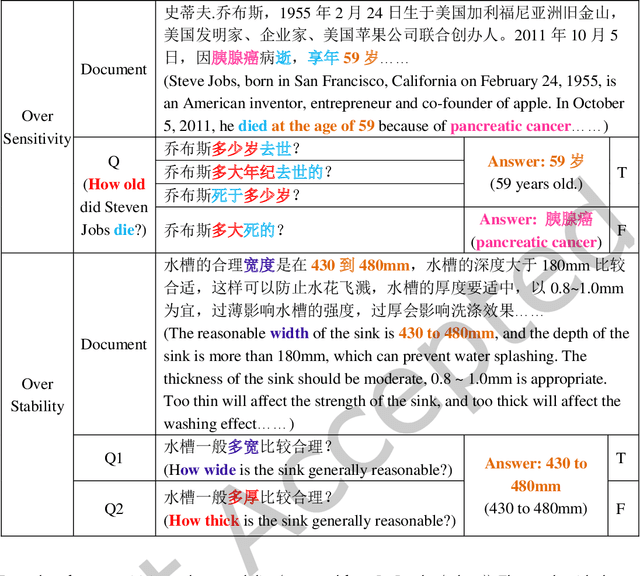
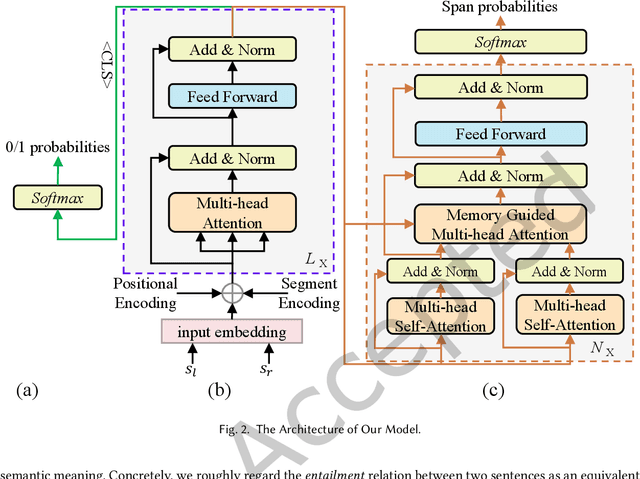
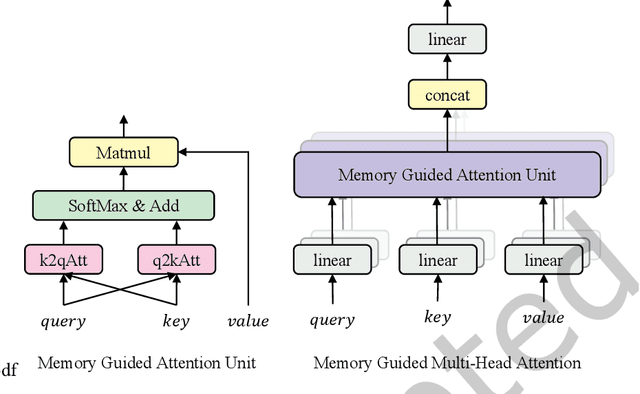

Abstract:Although existing machine reading comprehension models are making rapid progress on many datasets, they are far from robust. In this paper, we propose an understanding-oriented machine reading comprehension model to address three kinds of robustness issues, which are over sensitivity, over stability and generalization. Specifically, we first use a natural language inference module to help the model understand the accurate semantic meanings of input questions so as to address the issues of over sensitivity and over stability. Then in the machine reading comprehension module, we propose a memory-guided multi-head attention method that can further well understand the semantic meanings of input questions and passages. Third, we propose a multilanguage learning mechanism to address the issue of generalization. Finally, these modules are integrated with a multi-task learning based method. We evaluate our model on three benchmark datasets that are designed to measure models robustness, including DuReader (robust) and two SQuAD-related datasets. Extensive experiments show that our model can well address the mentioned three kinds of robustness issues. And it achieves much better results than the compared state-of-the-art models on all these datasets under different evaluation metrics, even under some extreme and unfair evaluations. The source code of our work is available at: https://github.com/neukg/RobustMRC.
Deep Understanding based Multi-Document Machine Reading Comprehension
Feb 25, 2022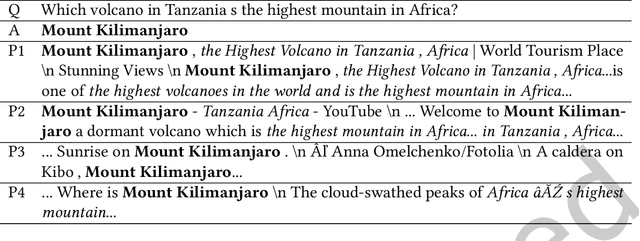
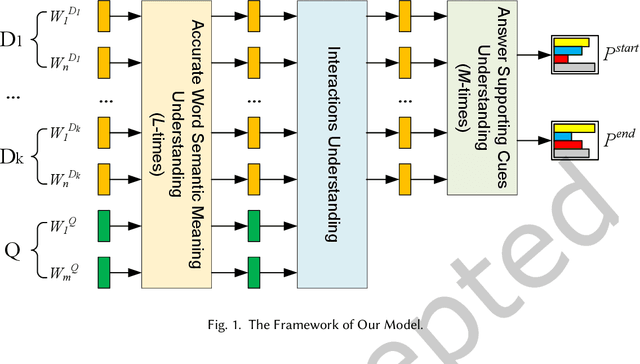

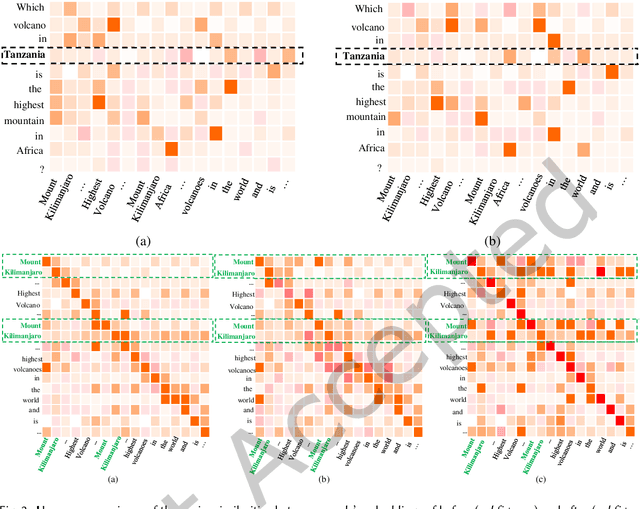
Abstract:Most existing multi-document machine reading comprehension models mainly focus on understanding the interactions between the input question and documents, but ignore following two kinds of understandings. First, to understand the semantic meaning of words in the input question and documents from the perspective of each other. Second, to understand the supporting cues for a correct answer from the perspective of intra-document and inter-documents. Ignoring these two kinds of important understandings would make the models oversee some important information that may be helpful for inding correct answers. To overcome this deiciency, we propose a deep understanding based model for multi-document machine reading comprehension. It has three cascaded deep understanding modules which are designed to understand the accurate semantic meaning of words, the interactions between the input question and documents, and the supporting cues for the correct answer. We evaluate our model on two large scale benchmark datasets, namely TriviaQA Web and DuReader. Extensive experiments show that our model achieves state-of-the-art results on both datasets.
A Simple but Effective Bidirectional Framework for Relational Triple Extraction
Jan 05, 2022
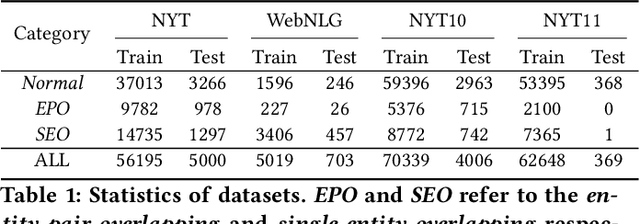
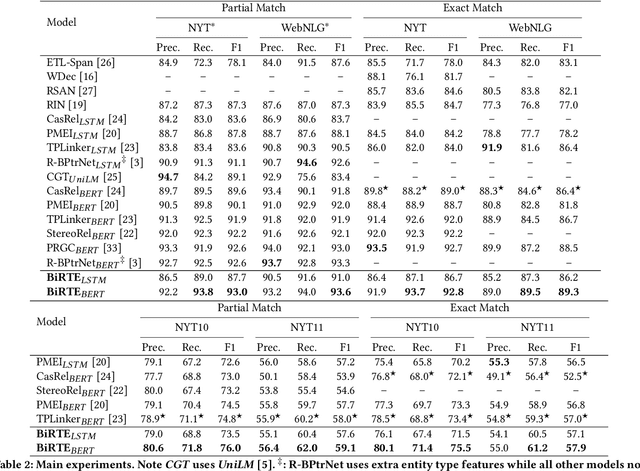

Abstract:Tagging based relational triple extraction methods are attracting growing research attention recently. However, most of these methods take a unidirectional extraction framework that first extracts all subjects and then extracts objects and relations simultaneously based on the subjects extracted. This framework has an obvious deficiency that it is too sensitive to the extraction results of subjects. To overcome this deficiency, we propose a bidirectional extraction framework based method that extracts triples based on the entity pairs extracted from two complementary directions. Concretely, we first extract all possible subject-object pairs from two paralleled directions. These two extraction directions are connected by a shared encoder component, thus the extraction features from one direction can flow to another direction and vice versa. By this way, the extractions of two directions can boost and complement each other. Next, we assign all possible relations for each entity pair by a biaffine model. During training, we observe that the share structure will lead to a convergence rate inconsistency issue which is harmful to performance. So we propose a share-aware learning mechanism to address it. We evaluate the proposed model on multiple benchmark datasets. Extensive experimental results show that the proposed model is very effective and it achieves state-of-the-art results on all of these datasets. Moreover, experiments show that both the proposed bidirectional extraction framework and the share-aware learning mechanism have good adaptability and can be used to improve the performance of other tagging based methods. The source code of our work is available at: https://github.com/neukg/BiRTE.
A Novel Global Feature-Oriented Relational Triple Extraction Model based on Table Filling
Sep 14, 2021Abstract:Table filling based relational triple extraction methods are attracting growing research interests due to their promising performance and their abilities on extracting triples from complex sentences. However, this kind of methods are far from their full potential because most of them only focus on using local features but ignore the global associations of relations and of token pairs, which increases the possibility of overlooking some important information during triple extraction. To overcome this deficiency, we propose a global feature-oriented triple extraction model that makes full use of the mentioned two kinds of global associations. Specifically, we first generate a table feature for each relation. Then two kinds of global associations are mined from the generated table features. Next, the mined global associations are integrated into the table feature of each relation. This "generate-mine-integrate" process is performed multiple times so that the table feature of each relation is refined step by step. Finally, each relation's table is filled based on its refined table feature, and all triples linked to this relation are extracted based on its filled table. We evaluate the proposed model on three benchmark datasets. Experimental results show our model is effective and it achieves state-of-the-art results on all of these datasets. The source code of our work is available at: https://github.com/neukg/GRTE.
 Add to Chrome
Add to Chrome Add to Firefox
Add to Firefox Add to Edge
Add to Edge